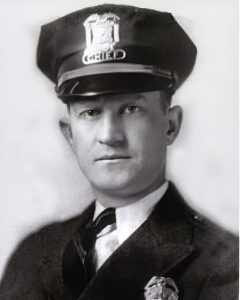
Photo info ...
Credit: Indianapolis Public LibraryView Source
(July 21, 1898-Mar. 25, 1985). Michael F. Morrissey was a son of immigrants from Limerick and Kerry, and, at 32, the youngest police chief in the city’s history, Morrissey also held the position longer than anyone, a record made possible by an unbroken line of Democratic mayors from the late 1920s to 1943 (see ).
His tenure was marked by devotion to efficiency, embracing the latest methods, recruitment of better-educated officers, and improvements in training (he established a 14-week police school). When a survey of police departments elsewhere convinced him of the need for a crime laboratory, Morrissey secured private support for a skilled technician until the city council appropriated the funds. By 1940, a trained scientist with the title of criminologist directed a fully equipped lab.
Morrissey initiated painting the patrol cars with stripes to increase visibility and substituting a “rubber slapper,” his own invention, for the flexible, weighted leather clubs then in use. But Morrissey also wiretapped prison cells, created a Red Squad to develop a list of names and addresses of suspicious persons, and boasted of his “Indianapolis system” in which “known criminals” were arrested, released, and rearrested until they left the city.
More positively, Morrissey raised standards for recruitment and seems to have supported the goals of the Merit Law of 1935. He wanted intelligent and quiet-spoken police, and, by 1938, he reported that most new officers were high school graduates with a sprinkling of college men. Applicants had to pass background checks and physical and psychological exams. Morrissey required officers to account for every minute of their day and kept statistics to identify high crime areas and thus deploy the department’s resources more effectively. A president and vice president of the International Association of Police Chiefs, Morrissey sent officers for training to the FBI and other police departments and used Indiana University to improve recruitment and promotion tests.
In 1945, Morrissey married, left Indianapolis to head the private police of the Pullman Company in Chicago, and later was chief of security for a General Electric plant. He returned to the city after retirement in 1964.

Help improve this entry
Contribute information, offer corrections, suggest images.
You can also recommend new entries related to this topic.